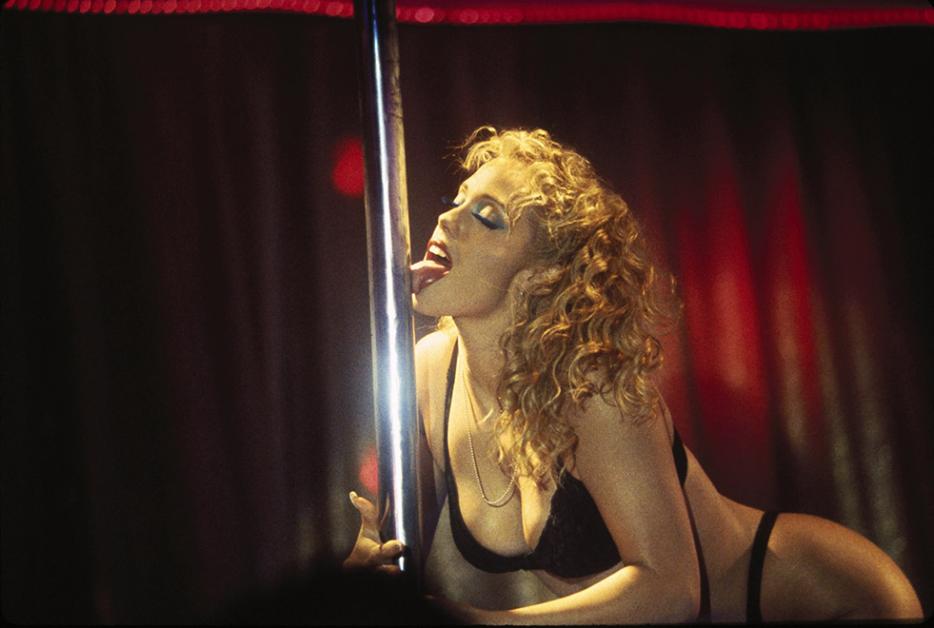An enduring misconception about Paul Verhoeven’s Showgirls is that it is, to invoke the favored cliche, “so bad it’s good.” This is a convenient narrative: deemed a catastrophic failure upon release in 1995, it subsequently found an audience of faux-enthusiasts who wanted to simply laugh at it, amplifying its notoriety in the way only such mock-rapturous word-of-mouth can. Its enduring reputation—as one of the worst studio films of the 1990s, certainly, but more importantly as one of the unintentionally funniest—is at least partly the result of a kind of echo chamber effect, in which expectations have been fixed so low for so long that even trying to approach it with an open mind or take any of it seriously now seems next to impossible. It’s hard not to laugh at something when you go into it believing that you should. And so every cut, every line reading, every dramatic beat, every broad joke, and (especially) every gesture toward sex becomes a punchline worth whooping over.
Except, of course, for one scene. Towards the end of the film, after Nomi Malone (Elizabeth Berkley) has finally secured her big break in the cutthroat world of Las Vegas dancing, an enormous house party is thrown in celebration of a successful opening night show. In the middle of the festivities, Molly (Gina Ravera), Nomi’s friend and colleague, finds herself alone in a bedroom with her long-beloved idol, a sleazy-looking rock musician named Andrew Carver. Suddenly, things take a sharp turn toward severe, as the movie seems to descend from high camp to complete chaos: Carver and his entourage proceed to brutally assault and eventually rape Molly, who is left hospitalized and without justice. This sequence, which is almost shockingly graphic and pretty obviously disturbing no matter how amusing one is inclined to find the film around it, is decidedly at odds with the popular conception of the film’s essential ridiculousness. It does not lend itself so well to ironic reappropriation. It is the precise opposite of “fun.” And it’s the most conspicuous sign that Verhoeven, despite here working in a populist mode and embellishing overtly campy elements by design, is making a serious film with much more on its mind than either its detractors or cult admirers prefer to grant it.
Showgirls, as certain critical circles have begun to embrace, is not “so bad it’s good.” Showgirls is good, or perhaps great, full stop. But one of the more intriguing things about the film is that it has so widely and so consistently been misunderstood by critics and audiences alike, despite the fact that its director, Paul Verhoeven, made a career in Hollywood out of highly commercial satires that freely indulge in the trash they’re mocking. It’s a constant throughout Verhoeven’s career: nearly every one of his American films, each of which is fiercely intelligent and provocative in its own way, was received at the time of its release with a combination of confusion and contempt, each in turn not so much rejected as a failure as, more frustratingly, dismissed as unworthy of serious thought.
The critical arc that follows Verhoeven’s American films is remarkably constant: what’s initially considered reprehensibly vacuous is invariably redeemed, in the long run, as a work of scathing satire too smart and subtle in its subversiveness to register as such immediately by critics not attuned to its rhythms. Even Starship Troopers, which seems in retrospect to be one of Verhoeven’s most blatantly angry and thoughtful satires—taking a fundamentally conservative book and reconfiguring it as a vitriolic treatise against American foreign policy and the exploitative foundation of the military industrial complex—was greeted, in 1997, with shrugs and sighs from critics who perceived it, quite wrongly, to be an endorsement of exactly the kind of violence it sought to undermine. Few filmmakers are as reliably misread by the mainstream.
It should come as no real surprise, then, that Paul Verhoeven’s shlock-horror B-movie Hollow Man was not well-received when it appeared in the year 2000. What’s slightly more surprising, however, is that in the decade-plus since its release, Hollow Man has never had the luxury of critical reappraisal, making it the only film of Verhoeven’s American period to remain more or less as poorly regarded in retrospect as it was all along. Hollow Man—a high-concept science fiction thriller in which a brilliant but arrogant scientist, played by Kevin Bacon, develops a serum which renders him invisible—does not have the usual assortment of high-brow defenders unpacking its intellectual underpinnings in the pages of Film Quarterly, as even a film as widely underappreciated as Showgirls has long had. Perhaps it’s that the film seems harder, somehow, to reclaim. It lacks a readily apparent satirical dimension, which quickly buoyed the reputations of Robocop and Starship Troopers; it’s missing the heated provocation that made Basic Instinct and Showgirls such canny navigators of controversy; and most of its basic sci-fi intrigue is summarily reduced, in the final act, to a fairly rote exercise in genre-movie violence. It isn’t an easy movie to love.
I won’t pretend that I have some special insight into Hollow Man that renders its faults oblique virtues, and I won’t strain to argue that it, like the others, is a masterpiece beset for years by misunderstanding. But it’s worth proposing something simpler: Hollow Man, though perhaps in many ways an artistic failure, is nevertheless as interesting as one might expect a Paul Verhoeven film to be. Whatever its problems—and, as has been exhaustively detailed elsewhere, it has many—the film represents a very intelligent attempt to work through some serious ideas about the way that we watch movies and, more broadly, interact with the world around us. The film approaches a sustained thesis conceptually: by presenting us with a man permitted to do anything he would like after he’s made invisible, the film essentially asks us what we would do were we bestowed with the same power.
But rather than simply letting the question linger, Hollow Man forces us by design to see a hypothetical scenario played out, teasing us with its possibilities: Bacon’s misanthropic scientist anti-hero, Sebastian Caine, finds himself instinctively drawn toward the illicit, at first using his invisibility to enjoy the thrill of watching others without them knowing they’re being watched and then, eventually, using the power to impose himself physically on others. What’s interesting about how this plays out is that Verhoeven makes us complicit all the way through: an early scene shows a woman scared to use the toilet because she feels as though she’s being invisibly watched, which we’re meant to realize she is—by us, the audience, who by the very nature of the cinema is always, like Caine, the physically absent voyeur. Caine gets a perverse pleasure out of watching others when he isn’t supposed to, as we naturally do watching illicit acts in movies, and his desire to reach out and interact with what he’s watching is meant to reflect our (perhaps hidden) desire to do the same. We’re meant to condemn his perversion and his breach of privacy, but at the same time Verhoeven is suggesting that we’re no better.
Hollow Man quickly takes this idea to its logical conclusion, and the climax of the story, before it becomes a routine action movie, culminates in Caine breaking into his neighbor’s apartment and raping her. The film received a great deal of criticism at the time for what was perceived to be misogyny, largely because this scene is so gratuitously lingered over and embellished—much of it is shot in first-person, or what looks like first-person, because we can never see Caine—but what Verhoeven wants us to confront is our own perverse desire, however latent, to see such grotesque acts committed for our observational pleasure, which is why it looks throughout the scene as though the camera, as a stand-in for us, is the one committing the assault. Verhoeven’s movies often took an audience’s desire for something—violence, sex, misanthropy—and shoved their faces in it, strong-arming them into recognizing their own wants and needs. That was the point of the rape scene in Showgirls, too: in a movie about extreme sexuality flaunted to satisfy the debased desires of a paying audience, this was the horrifying logical extreme. But it’s hard to get an audience to recognize their own worst impulses. It’s much easier to laugh and have a good time.
Film critic Adam Nayman will be presenting a special lecture on the films of director Paul Verhoeven next Monday, May 27th, at the Miles Nadal JCC in Toronto. General admission is $12. More information here.






